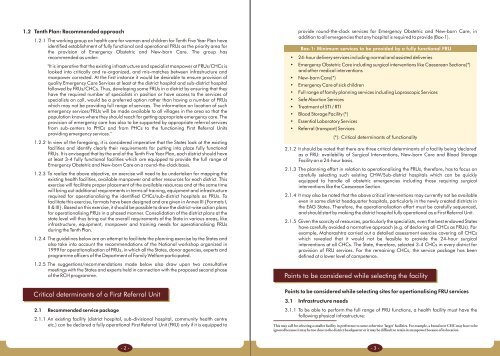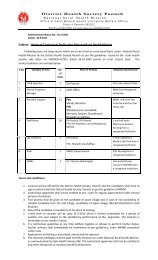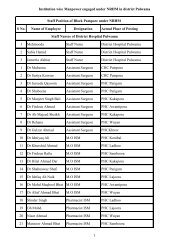Guidelines For Operationalising First Referral Units - National Rural ...
Guidelines For Operationalising First Referral Units - National Rural ...
Guidelines For Operationalising First Referral Units - National Rural ...
You also want an ePaper? Increase the reach of your titles
YUMPU automatically turns print PDFs into web optimized ePapers that Google loves.
1.2 Tenth Plan: Recommended approach<br />
1.2.1 The working group on health care for women and children for Tenth Five Year Plan have<br />
identified establishment of fully functional and operational FRUs as the priority area for<br />
the provision of Emergency Obstetric and New-born Care. The group has<br />
recommended as under:<br />
"It is imperative that the existing infrastructure and specialist manpower at FRUs/CHCs is<br />
looked into critically and re-organized, and mis-matches between infrastructure and<br />
manpower corrected. At the first instance it would be desirable to ensure provision of<br />
quality Emergency Care Services at least at the district hospital and sub-district hospital<br />
followed by FRUs/CHCs. Thus, developing some FRUs in a district by ensuring that they<br />
have the required number of specialists in position or have access to the services of<br />
specialists on call, would be a preferred option rather than having a number of FRUs<br />
which may not be providing full range of services. The information on location of such<br />
emergency services/FRUs will be made available to all villages in the area so that the<br />
population knows where they should reach for getting appropriate emergency care. The<br />
provision of emergency care has also to be supported by appropriate referral services<br />
from sub-centers to PHCs and from PHCs to the functioning <strong>First</strong> <strong>Referral</strong> <strong>Units</strong><br />
providing emergency services."<br />
1.2.2 In view of the foregoing, it is considered imperative that the States look at the existing<br />
facilities and identify clearly their requirements for putting into place fully functional<br />
FRUs. It is envisaged that by the end of the Tenth Five Year Plan, each district should have<br />
at least 3-4 fully functional facilities which are equipped to provide the full range of<br />
Emergency Obstetric and New-born Care on a round-the-clock basis.<br />
1.2.3 To realize the above objective, an exercise will need to be undertaken for mapping the<br />
existing health facilities, available manpower and other resources for each district. This<br />
exercise will facilitate proper placement of the available resources and at the same time<br />
will bring out additional requirements in terms of training, equipment and infrastructure<br />
required for operationalising the identified CHCs/sub-district hospitals as FRUs. To<br />
facilitate this exercise, formats have been designed and are given in Annex III {<strong>For</strong>mats I,<br />
II & III}. Based on this exercise, it should be possible to draw the district-wise action plans<br />
for operationalising FRUs in a phased manner. Consolidation of the district plans at the<br />
state level will thus bring out the overall requirements of the State in various areas, like<br />
infrastructure, equipment, manpower and training needs for operationalising FRUs<br />
during the Tenth Plan.<br />
1.2.4 The guidelines below are an attempt to facilitate the planning exercise by the States and<br />
also take into account the recommendations of the <strong>National</strong> workshop organized in<br />
1999 for operationalisation of FRUs, in which all the States, donor agencies, experts and<br />
programme officers of the Department of Family Welfare participated.<br />
1.2.5 The suggestions/recommendations made below also draw upon two consultative<br />
meetings with the States and experts held in connection with the proposed second phase<br />
of the RCH programme.<br />
provide round-the-clock services for Emergency Obstetric and New-born Care, in<br />
addition to all emergencies that any hospital is required to provide (Box-1).<br />
Box-1: Minimum services to be provided by a fully functional FRU<br />
• 24-hour delivery services including normal and assisted deliveries<br />
• Emergency Obstetric Care including surgical interventions like Caesarean Sections(*)<br />
and other medical interventions<br />
• New-born Care(*)<br />
• Emergency Care of sick children<br />
• Full range of family planning services including Laproscopic Services<br />
• Safe Abortion Services<br />
• Treatment of STI / RTI<br />
• Blood Storage Facility (*)<br />
• Essential Laboratory Services<br />
• <strong>Referral</strong> (transport) Services<br />
(*): Critical determinants of functionality<br />
2.1.2 It should be noted that there are three critical determinants of a facility being 'declared'<br />
as a FRU: availability of Surgical Interventions, New-born Care and Blood Storage<br />
Facility on a 24-hour basis.<br />
2.1.3 The planning effort in relation to operationalising the FRUs, therefore, has to focus on<br />
carefully selecting such existing CHW/Sub-district hospitals which can be quickly<br />
equipped to handle all obstetric emergencies including those requiring surgical<br />
interventions like the Caesarean Section.<br />
2.1.4 It may also be noted that the above critical interventions may currently not be available<br />
even in some district headquarter hospitals, particularly in the newly created districts in<br />
the EAG States. Therefore, the operationalisation effort must be carefully sequenced,<br />
and should start by making the district hospital fully operational as a <strong>First</strong> <strong>Referral</strong> Unit.<br />
2.1.5 Given the scarcity of resources, particularly the specialists, even the best endowed States<br />
have carefully avoided a normative approach (e.g. of declaring all CHCs as FRUs). <strong>For</strong><br />
example, Maharashtra carried out a detailed assessment exercise covering all CHCs<br />
which revealed that it would not be feasible to provide the 24-hour surgical<br />
interventions at all CHCs. The State, therefore, selected 3-4 CHCs in every district for<br />
provision of FRU services. <strong>For</strong> the remaining CHCs, the service package has been<br />
defined at a lower level of competence.<br />
Points to be considered while selecting the facility<br />
Critical determinants of a <strong>First</strong> <strong>Referral</strong> Unit<br />
2.1 Recommended service package<br />
2.1.1 An existing facility (district hospital, sub-divisional hospital, community health centre<br />
etc.) can be declared a fully operational <strong>First</strong> <strong>Referral</strong> Unit (FRU) only if it is equipped to<br />
Points to be considered while selecting sites for opertionalising FRU services<br />
3.1 Infrastructure needs<br />
3.1.1 To be able to perform the full range of FRU functions, a health facility must have the<br />
following physical infrastructure:<br />
This may call for selecting a smaller facility in preference to some otherwise 'larger' facilities. <strong>For</strong> example, a brand new CHC may have to be<br />
ignored because it may be too close to the district headquarter or it may be difficult to retain its manpower because of its location.<br />
- 2 -<br />
- 3 -

















